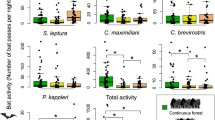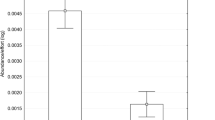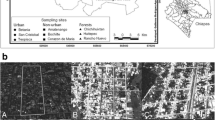Abstract
We monitored foraging insectivorous bats along walked transects in forest and farmland at Arabuko-Sokoke Forest in coastal Kenya, using a heterodyne bat detector. The main purpose was to test whether aerial-hawking insectivorous bats that feed in open places (in this case mostly Scotophilus and Scotoecus spp.) show lunar phobia, i.e. restricting their activity on moonlit nights. Such behavior would be an expected response to the threat posed by visually oriented aerial predators such as bat hawks, owls and carnivorous bats. The occurrence of lunar phobia in bats is a controversial issue and may have implications for how bats will be affected by increasing light pollution. Our results show that foraging activity of the bats that we studied was related to time of day, season, and habitat, albeit with no additional effect of moonlight discernable. We therefore conclude that foraging activity occurs independently of moonlight. This result is partly at odds with previous findings including predictions from a meta-analysis of lunar phobia in bats, which indicates that lunar phobia is common in these animals, though most likely to be present in tropical species that feed in open situations near vegetation and over water. Equally, our results conform to findings from studies of aerial insectivorous bats in tropical as well as temperate areas, most of which have failed to reveal any clear evidence of lunar phobia. We believe that moonlight generally does not facilitate aerial predation on flying bats in open situations, or, alternatively, the bats accept increased predation pressure while they fulfil the energetic requirements through hunting.
Similar content being viewed by others
References
Aguiar, L.M.S., Marinho-Filho, J.S., 2004. Activity patterns of nine phyllostomid bat species in a fragment of the Atlantic Forest in southeastern Brazil. Rev. Bras. Zool. 21, 385–390, http://dx.doi.org/10.1590/S0101-81752004000200037).
Appel, G., López-Baucells, A., Magnusson, W.E., Bobrowiec, P.E.D., 2017. Aerial insectivorous bat activity in relation to moonlight intensity. Mamm. Biol. 85, 37–46, http://dx.doi.org/10.1016/j.mambio.2016.11.005).
Azen, R., Budescu, D.V., Reiser, B., 2001. Criticality of predictors in multiple regression. Br. J. Math. Stat. Psychol. 54, 201–225, http://dx.doi.org/10.1348/000711001159483).
Barton, K., 2016. MuMIn: Multi-Model Inference. R Package Version 1.15.6. https://CRAN.R-project.org/package=MuMIn.
Bates, P.J.J., Harrison, D.L., 1997. Bats of the Indian Subcontinent. Harrison Zoological Museum, Sevenoaks, U.K.
Bates, D., Maechler, M., Bolker, B., Walker, S., 2015. Fitting linear mixed-effects models using lme4. J. Stat. Softw. 67, 1–48, http://dx.doi.org/10.18637/jss. v067.i01).
Bell, G.P., 1985. The sensory basis for prey location by the California leaf-nosed bat Macrotus californicus (Chiroptera: Phyllostomidae). Behav. Ecol. Sociobiol. 16, 343–247.
Bennun, L.A., Njoroge, P., 1999. Important Bird Areas in Kenya. Nature Kenya, Nairobi.
Bolker, B.M., Brooks, M.E., Clark, C.J., Geange, S.W., Poulsen, J.R., Stevens, M.H.H., White, J.S.S., 2009. Generalized linear mixed models: a practical guide for ecology and evolution. Trends Ecol. Evol. 24, 127–135, http://dx.doi.org/10.1016/j.tree.2008.10.008).
Börk, K.S., 2006. Lunar phobia in the greater fishing bat Noctilio leporinus (Chiroptera: Noctilionidae). Rev. Biol. Trop. 54, 1117–1123.
Brooks, D.M., Bickham, J.W., 2014. New Species of Scotophilus (Chiroptera: Vespertilionidae) from sub-Saharan Africa, 326. Occasional Papers of the Museum of Texas Tech University, pp. 1–21.
Burnham, K.P., Anderson, D.R., 2002. Model Selection and Multimodel Inference: A Practical Information-Theoretic Approach, 2nd ed. Springer, New York.
Crespo, R.F., Linhart, S.B., Burns, R.J., Mitchell, CG., 1972. Foraging behaviour of the common vampire bat related to moonlight. J. Mammal. 53, 366–368, http://dx.doi.org/10.2307/1379175).
Demos, T.C., Webala, P.A., Bartonjo, M., Patterson, B.D., 2018. Hidden diversity of African yellow house bats (Vespertilionidae, Scotophilus): insights from multilocus phylogenetics and lineage delimitation. Front. Ecol. Evol. 6, 86, http://dx.doi.org/10.3389/fevo.2018.00086.
Eklöf, J., Svensson, A.M., Rydell, J., 2002. Northern bats (Eptesicus nilssonii) use vision but not flutter-detection when searching for prey in clutter. Oikos 99, 347–351, http://dx.doi.org/10.1034/j.1600-0706.2002.990216.x.
Elangovan, V., Marimuthu, G., 2001. Effect of moonlight on the foraging behaviour of a megachiropteran bat Cynopterus sphinx. J. Zool. Lond. 253, 347–350, http://dx.doi.org/10.1017/S0952836901000310.
Erkert, H.G., 1974. Der Einfluss der Mondlichts auf die Aktivitätsperiodik nachtaktiver Säugetiere. Oecologia 14, 269–287.
Esberard, C.E.L., Vrcibradic, D., 2007. Snakes preying on bats: new records from Brazil and a review of recorded cases in the Neotropical region. Rev. Bras. Zool. 24, 848–853, http://dx.doi.org/10.1590/S0101-81752007000300036.
Fox, J., 2003. Effect displays in R for generalised linear models. J. Stat. Softw. 8, 1–27, http://dx.doi.org/10.18637/jss.v008.i15).
Galipaud, M., Gillingham, M.A.F., Dechaume-Moncharmont, F.X., 2017. A farewell to the sum of Akaike weights: the benefits of alternative metrics for variable importance estimations in model selection. Methods Ecol. Evol. 38, 42–49, http://dx.doi.org/10.1111/2041-210X.12835.
Gannon, M.R., Willig, M.R., 1997. The effect of lunar illumination on movement and activity of the red fig-eating bat (Stenoderma rufum). Biotropica 29, 525–529, http://dx.doi.org/10.1111/j.1744-7429.1997.tb00048.x.
Giam, X., Olden, J.D., 2016. Quantifying variable importance in a multimodel inference framework. Methods Ecol. Evol. 7, 388–397, http://dx.doi.org/10.1111/2041-210X.12492.
Halat, Z., Dechmann, D.K.N., Zegarek, M., Visser, A.E.J., Ruczynski, I., 2018. Sociality and insect abundance affect duration of nocturnal activity of male parti-colored bats. J. Mammal. 99, 1503–1509, http://dx.doi.org/10.1093/jmammal/gyy141.
Hartley, R., Hustler, K., 1993. A less-than-annual breeding cycle in a pair of African bat hawks Machaeramphus alcinus. Ibis 135, 456–458, http://dx.doi.org/10.1111/j.1474-919X.1993.tb02119.x.
Hecker, K.R., Brigham, R.M., 1999. Does moonlight change vertical stratification of activity by forest-dwelling insectivorous bats? J. Mammal. 80, 1196–1201, http://dx.doi.org/10.2307/1383170).
Holland, R.A., Meyer, C.F.J., Kalko, E.K.V., Kays, R., Wikelski, M., 2011. Emergence time and foraging activity in Pallasmastiff bat Molossus (Chiroptera: Molossidae) in relation to sunset/sunrise and phase of the moon. Acta Chiropt. 13, 399–404, http://dx.doi.org/10.3161/150811011X624875.
Horning, M., Trillmich, F., 1999. Lunar cycles in diel prey migrations have a stronger effect on the diving of juvenile than adult Galápagos fur seals. Proc. R. Soc. Lond. B 266, 1127–1132, http://dx.doi.org/10.1098/rspb.1999.0753.
Kardong, K.V., Bels, V.L., 1998. Rattlesnake strike behavior: kinematics. J. Exp. Biol. 201, 837–850.
Karlsson, B.L., Eklöf, J., Rydell, J., 2002. No lunar phobia in swarming insectivorous bats. J. Zool. Lond. 256, 473–477.
Kelsey, M.G., Langton, T.E.S., 1983. The Conservation of the Arabuko-sokoke Forest, Kenya. ICBP Technical Report. Cambridge, UK.
Kronfeld-Schor, N., Dominoni, D., de la Iglesia, H., Levy, O., Herzog, E.D., Dayan, T., Helfrich-Foster, C., 2013. Chronobiology by moonlight. Proc. R. Soc. Lond. B 280 (1765), http://dx.doi.org/10.1098/rspb.2012.3088).
Kyba, C.C.M., Mohar, A., Posch, T., 2017. How bright is moonlight? Astron. Geophys 58, http://dx.doi.org/10.1093/astrogeo/atx025), 1.31-1.32.
Lang, A.B., Kalko, E.K.V., Römer, H., Bockholdt, C., Dechmann, D.K.N., 2005. Activity levels of bats and katydids in relation to the lunar cycle. Oecologia 146, 659–666, http://dx.doi.org/10.1007/s00442-005-0131–3.
McWilliam, A.N., 1987. Territorial and pair behaviour of the African false vampire bat, Cardioderma cor (Chiroptera: Megadermatidae) in coastal Kenya. J. Zool. Lond. 213, 243–252.
Mello, M.A.R., Kalko, E.K.V., Silva, W.R.S., 2013. Effects of moonlight on the capturability of frugivorous phyllostomid bats (Chiroptera: Phyllostomidae) at different time scales. Zoologia 30, 397–402, http://dx.doi.org/10.1590/S1984-46702013000400005).
Meyer, C.F.J., Schwarz, C.J., Fahr, J., 2004. Activity patterns and habitat preferences of insectivorous bats in a West African forest-savanna mosaic. J. Trop. Ecol. 20, 397–407, http://dx.doi.org/10.1017/S0266467404001373.
Mikula, P., Morelli, F., Lucan, R.K., Jones, D.N., Tryjanowski, P., 2016. Bats as prey of diurnal birds: a global perspective. Mamm. Rev. 46, 160–174, https://doi.org/10.1111/mam.12060.
Molinari, J., Gutierrez, E.E., Ascebcão, A.A., Arends, A., Marquis, R.J., 2005. Predation by giant centipedes, Scolopendra gigantea, on three species of bats in a Venezuelan cave. Caribb.J. Sci. 41, 340–346, http://dx.doi.org/10.1590/S1984-4689zool-20160026.
Monadjem, A., Taylor, P.J., Cotterill, F.P.D., Schoeman, M.C., 2010. Bats of Southern and Central Africa. A Biogeographic and Taxonomic Synthesis. Wits Press, Johannesburg.
Morrison, D.W., 1978. Lunar phobia in a neotropical fruit batArtibeus jamaicensis (Chiroptera: Phyllostomidae). Anim. Behav. 26, 852–855, http://dx.doi.org/10. 1016/0003-3472(78)90151-3).
Morrison, D.W., 1980. Foraging and day-roosting dynamics of canopy fruit bats in Panama. J. Mammal. 61, 20–29, http://dx.doi.org/10.2307/1379953).
Muchiri, M.N., Kiriinya, C.K., Mbithi, D.M., 2001. Forestry Inventory Report forthe Indigenous Forest in Arabuko-Sokoke Forest Reserve. Kenya Forestry Research Institute, Nairobi, Kenya.
Murphy, M., Clare, E.L., Rydell, J., Yovel, Y., Bar-On, Y., Oelbaum, P., Fenton, M.B., 2016. Opportunistic use of banana flower bracts by Glossophaga soricina. Acta Chiropt. 18, 209–213, http://dx.doi.org/10.3161/15081109ACC2016.18.1.011.
Musila, S., Prokop, P., Gichuki, G., 2018a. Knowledge and perceptions of, and attitudes to, bats by people living around Arabuko-Sokoke Forest, Malindi-Kenya. Anthrozosö 31, 247–262, http://dx.doi.org/10.1080/08927936. 2018.1434065.
Musila, S., Syingi, R., Gichuki, N., Castro-Arellano, I., 2018b. Bat activity in the interior of Arabuko-Sokoke forest and adjacent farmlands in Kenya. J. Bat Res. Conserv. 11, http://dx.doi.org/10.14709/BarbJ.11.1.2018.05.
Nakagawa, S., Johnson, P.C.D., Schielzeth, H., 2017. The coefficient of determination R2 and intra-class correlation coefficient from generalized linear mixed-effects models revisited and expanded. J. R. Soc. Interface 14 (2017), 0213, http://dx.doi.org/10.1098/rsif.2017.0213.
Negraeff, O.E., Brigham, R.M., 1995. The influence of moonlight on the activity of little brown bats (Myotis lucifugus). Zeitschrift für Säugetierkunde 60, 330–336
Nogueira, M.R., Monteiro, L.R., Peracchi, A.L., 2006. New evidence of bat predation by the woolly false vampire bat Chrotopterus auritus. Chiroptera Neotropical 12, 286–288.
R Core Team, 2017. R: A Language and Environment for Statistical Computing. R Foundation for Statistical Computing, Vienna, Austria https://www.R-project.org/.
Ryan, M.J., Tuttle, M.D., 1987. The role of prey-generated sounds, vision, and echolocation in prey localization by the African bat Cardioderma cor (Megadermatidae). J. Comp. Physiol. 161, 59–66, http://dx.doi.org/10.1016/BF00609455).
Rydell, J., 1992. Exploitation of insects around streetlamps by bats in Sweden. Funct. Ecol. 6, 744–750, http://dx.doi.org/10.2307/2389972).
Rydell, J., Eklöf, J., Sánchez-Navarro, S., 2017. Age of enlightenment: long-term effects of outdoor aesthetic lights on bats in churches. R. Soc. Open Sci., 4, http://dx.doi.org/10.1098/rsos.161077).
Saldan˜a-Vázquez, R.A., Munguía-Rosas, M.A., 2012. Lunar phobia in bats and its ecological correlates: a meta-analysis. Mamm. Biol. 78, 216–219, http://dx.doi.org/10.1016/j.mambio.2012.08.004).
Schoeman, M.C., 2015. Light pollution at stadiums favors urban exploiter bats. Anim. Conserv. 19, 120–130, http://dx.doi.org/10.1111/acv.12220).
Singaravelan, N., Marimuthu, G., 2002. Moonlight inhibits and lunar eclipse enhances foraging activity of fruit bats in an orchard. Curr. Sci. India 82, 1020–1022.
Speakman, J.R., 1991. The impact of predation by birds on bat populations in the British Isles. Mamm. Rev. 21, 123–142, http://dx.doi.org/10.1111/j.1365-2907.1991.tb00114.x).
Stone, E.L., Harris, S., Jones, G., 2015. Impacts of artificial lighting on bats: a review of challenges and solutions. Mamm. Biol. 80, 213–219, http://dx.doi.org/10. 1016/j.mambio.2015.02.004.
Subbaraj, R., Balasingh, J., 1996. Night roosting and ‘lunar phobia’ in Indian false vampire bat Megaderma lyra. J. Bombay Nat. Hist. Soc. 93, 1–7.
Surlykke, A.M., Miller, LA., Mohl, B., Andersen, B.B., Christensen-Dalsgaard, J., Jorgensen, M.B., 1993. Echolocation in two very small bats from Thailand, Craseonycteris thonglongyai and Myotis siligorensis. Behav. Ecol. Sociobiol. 33, 1–12.
Symonds, M.R.E., Moussalli, A., 2011. A brief guide to model selection, multimodel inference and model averaging in behavioural ecology using Akaike’s information criterion. Behav. Ecol. Sociobiol. 65, 13–21, http://dx.doi.org/10. 1007/s00265-010-1037-6).
Thies, W., Kalko, E.K.V., Schnitzler, H.U., 2006. Influence of environment and resource availability on activity patterns ofCarollia castanea (Phyllostomidae) in Panama. J. Mammal. 87, 331–338, http://dx.doi.org/10.1644/05-MAMM-A-161R1.1).
Tidemann, CR., Priddel, D.M., Nelson, J.E., Pettigrew, J.D., 1985. Foraging behaviour of the Australian ghost bat, Macroderma gigas (Microchiroptera: Megadermatidae). Aust.J. Zool. 33, 705–713, http://dx.doi.org/10.1071/ZO9850705).
Tuttle, M.D., Ryan, M.J., 1982. The role of synchronized calling, ambient light, and ambient noise, in anti-bat-predator behavior of a treefrog. Behav. Ecol. Sociobiol. 11, 125–131.
Vaughan, TA, Vaughan, R.P., 1986. Seasonality and the behavior of the African yellow-winged bat. J. Mammal. 67, 91–102.
Voigt, C.C., Azam, C., Dekker, J., Ferguson, J., Fritze, M., Gazaryan, S., Hölker, F., Jones, G., Leader, N., Lewanzik, D., Limpens, H.J.G.A., Mathews, F., Rydell, J., Schofield, H., Spoelstra, K., Zagmajster, M., 2018. Guidelines for Considerations of Bats in Lighting Projects. EUROBATS Publications no. 8. UNEP/EUROBATS Secretariat, Bonn, Germany, 62 pp.
Williams, C.B., 1936. The influence of moonlight on the activity of certain nocturnal insects, particularly of the family Noctuidae as indicated by a light trap. Philos. Trans. R. Soc. Lond. B Biol. Sci. 226, 357–389, http://dx.doi.org/10.1098/rstb. 1936.0010).
Author information
Authors and Affiliations
Corresponding author
Rights and permissions
About this article
Cite this article
Musila, S., Bogdanowicz, W., Syingi, R. et al. No lunar phobia in insectivorous bats in Kenya. Mamm Biol 95, 77–84 (2019). https://doi.org/10.1016/j.mambio.2019.03.002
Received:
Revised:
Published:
Issue Date:
DOI: https://doi.org/10.1016/j.mambio.2019.03.002




